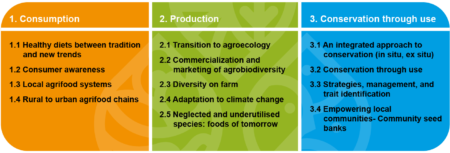- No buzz for bees: Media coverage of pollinator decline. Nobody cares. Unless it’s linked to climate change.
- Climate impacts associated with reduced diet diversity in children across nineteen countries. Something else that’s linked to climate change and too few care about.
- People are essential to linking biodiversity data. Seriously, get an ORCID ID.
- Why European biodiversity reporting is not reliable. It’s the free indicator choice in CBD reporting is what it is. Also, not enough attention to genetic diversity. Now, where have I heard that before?
- Reversing extinction trends: new uses of (old) herbarium specimens to accelerate conservation action on threatened species. Not just useful in generating new knowledge (including on genetic diversity), can also be used as seed sources and in public awareness.
- Ex Ante Assessment of Returns on Research Investments to Address the Impact of Fusarium Wilt Tropical Race 4 on Global Banana Production. Conventional breeding for resistance could lift almost a million people out of poverty. That would be quite the indicator.
- Genomic resources in plant breeding for sustainable agriculture. Would help with the above.
- Can Niche Markets for Local Cacao Varieties Benefit Smallholders in Peru and Mexico? Maybe. Read it, it’s not that long.
- Quantifying and addressing the prevalence and bias of study designs in the environmental and social sciences. Everyone should use randomised designs and controlled observational designs with pre-intervention sampling. No, you did not just waste your time reading the above.
- Crop wild relatives of the United States require urgent conservation action. 60% of 600 native taxa need urgent help.
- Limits and constraints to crop domestication. Most of the world’s 2000 crops are not fully domesticated, for reasons such as trait architecture, lack of diversity in domestication traits, accumulation of genetic load and gene flow from the above. But something can be done about it.
And we’re off…
The call for abstracts for the 2nd International Agrobiodiversity Congress – Agrobiodiversity for Food System Transformation, is now open. The Congress, scheduled for October 2021, will focus on the role that agrobiodiversity can play in positively changing our food systems. The deadline for abstract submission is 18 April 2021.
Go for it.

Nibbles: Chickpea, Rice, Potato, Open seeds, Ipomoea, Cider apples, Functional foods, Colombian seeds, Meaty diets, Coffee ritual
- Chickpea breeding in the news, if you can believe it.
- Somehow rice breeding in the news is easier to believe.
- Or potato breeding, for that matter.
- The case for public ownership of seed. Now, that would be news.
- I doubt that changing the sweet potato’s scientific name will ever be news.
- Michigan’s cider lovers round up their favourite apples.
- Visualization on how to make functional foods sustainable.
- A Colombian (seed) exchange.
- People have always eaten meat. Sure, but so what?
- Anyone for coffee?
Nibbles: Macron magic, UK Strategic Priorities Fund, Macadamia, Tepary, Nordic spuds, Diversification, Carolina rice, Couscous, Wild tobacco, Yeast diversity, Da 5 Foods
- France pushes for agricultural development. Money to follow mouth?
- Meanwhile, Britain puts its money into its own food systems.
- The macadamia is not diverse enough. Who’d have thought it.
- Couscous gets protected. Phew, ’cause it’s right on the verge of extinction, isn’t it.
- I hope tepary beans don’t become the next macadamia.
- Reviving old potatoes the Nordic way.
- Malaysia told to look beyond oil palm. To tepary and macadamia, maybe?
- Speaking of diversification, how about Laotian rice in Appalachia?
- Chasing the wild tobacco. See what I did there?
- Yeast has been domesticated by bakers into two genetic groups: industrial and artisanal sourdough.
- A history of the world in entirely the wrong 5 foods.
Working to understand and conserve genetic diversity
Just catching up on a couple of useful resources.
The Genetics Composition working group [of the Group on Earth Observations’s Biodiversity Observation Network] aims to develop, test and improve approaches for assessing and interpreting genetic diversity.
You can join it here. And thus contribute to the Genetic diversity targets and indicators proposed for the CBD post-2020 Global Biodiversity Framework. About which you can read more on the work blog, as it happens. The working group seems to have some overlap with the Conservation Genetic Coalition, which came out with its formal “Statement on genetic diversity in CBD” just before Christmas.
Meanwhile, over at USDA, there are posters on crop diversity and genebanks in multiple languages.
Gotta wonder whether any of this will reach the policy-makers, but one can hope, can’t one?